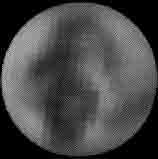|
         
> The Sun
> Mercury
> Venus
> Earth
> Mars
> Jupiter
> Saturn
> Uranus
> Neptune
> Pluto
> The 10th Planet?
> Asteroids
> Comets
> The 'Edge'
  
|
Most astronomers
believe that Pluto is a huge comet. There is almost no doubt that if it
were discovered todat, it would be considered a giant Kuiper Belt
Object.
However, it was discovered in 1930 by Clyde Tombaugh. It was initially
theorized to exist due to
perturbations in Neptune's orbit, calculated in 1905.

One reason that it took so long to find Pluto is due to its highly
eccentric orbit, and the fact that it does not orbit in the same plane as
the rest of the planets. What this means is that most of the planets all
orbit within a few degrees of a plane. Pluto's orbit is inclined by about
17°. It's orbit also has high eccentricity, such that for brief periods of
time, Pluto is closer to the sun than Neptune. However, it will not ever
collide with Neptune because it orbits three times for each two times
Neptune does around the sun, a phenomenon called resonance.
Pluto's composition also seems to support the comet theory. It is made up
of a rock and ice mixture. At the poles are frozen methane. Also methane
and nitrogen snow fall there. Near the equator, the ground is a reddish
color, and no snow falls there -- this is what could be expected of a
giant comet orbiting far from the sun.
That is about the limit of what we can tell about Pluto. It is so far away
that even the Hubble Space Telescope (HST) can tell us very little. HST is
one of the few telescopes that can separate the images of Pluto and its
moon, Charon.
So, one might ask, how do scientists know as much as they do? Twice in its
248-year orbit, Charon transits, or crosses in front of Pluto, relative to
Earth. By chance, one of them occurred between the years of 1985-1990. If
Charon had been discovered a few years later, we would have had to wait
until 2109 before we could see this.
When Charon crossed Pluto, it blocked out part of the light that Pluto
reflects. The information was then fed into computers. Each time Charon
crossed Pluto, it covered a slightly different portion. This allowed
scientists to create a rough map of Pluto.
As to whether Pluto is considered a planet or not, the International
Astronomical Union (IAU), the only official body that decides the status
or names of celestial bodies, has not changed the status of Pluto's
planet-hood. No matter what some people may believe, it is still
officially considered a planet until or unless the IAU changes this.
Unique
Characteristics
Pluto has many unique attributes. First, its moon, Charon,
is fully half as large as its companion. Therefore, scientists sometimes
classify Pluto as a double planet. Another characteristic is that Pluto's
atmosphere, though very thin, and it extends into space far enough to
engulf its moon.
Pluto's atmosphere grew as it approached the sun. But, as it is moving
farther away, its atmosphere is freezing, and falling as snow. This is
another reason why many scientists think that Pluto may not be a planet at
all, but the king of comets. (As a comet approaches the sun, its gases
begin to melt and surround it in what is called a coma. When it goes
farther away, the gases re-freeze and are either lost in space, or rejoin
the nucleus. This seems to be what is happening to Pluto.)
Another thing that is unique about Pluto is its orbit. While all the other
planets follow nearly circular paths, and are almost all on the same
plane, Pluto's orbit is so erratic that it can go as far as seventeen
degrees above the "planetary plane." Its orbit is also so oval that it
comes as close to the Sun as 30 A.U.'s, but can go as far as 50 A.U.'s.
[Top] Pluto's
Satellite
Very little about Charon is known -- less than Pluto,
even. Charon was discovered in 1977 in what looked like a picture of Pluto
with a little pimple growing out of its side. Due to very careful
measurements, it helped to determine some characteristics of Pluto as well
as itself.
It was found that Charon orbits at about 19,600 km (12,200 miles) from
Pluto. It's day is approximately 6.387 of our days, and it is tidally
locked with Pluto, meaning that, like our moon, it always presents the
same face to Pluto - its year is as long as its day. Charon is 593 km (368
miles) in radius, and weighs 1.9x1021 kg. This means that Charon is about
50% as large as Pluto in diameter, and weighs 15% as much.
Charon is enveloped by Pluto's atmosphere. Charon has a gray surface,
which reflects about one-half of the light it receives. It was mapped the
same way Pluto was from the Pluto-Charon transits that occurred between
1985-1990. If Charon hadn't been discovered in 1977, we might not have
been able to map it until 124 years later.
Charon is the moon of Pluto. But, is it more than just a moon, or should
it be called something else? Some astronomers think that since Charon is
fully half the diameter of Pluto, that it should be considered a planet.
So, you could call the Pluto-Charon system.
But, if Pluto is a comet, then should Charon be a
comet too? There is a
large asteroid called Ida that has a small moon. The moon isn't called an
asteroid, so if Pluto is a comet, should Charon be called a
comet, too?
[Top] External Links
[Back] [Top] [Next] |
